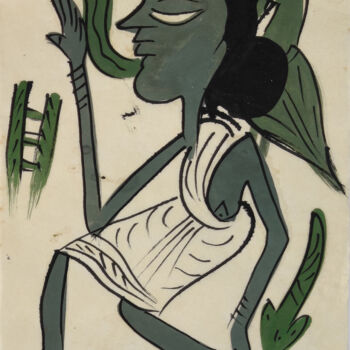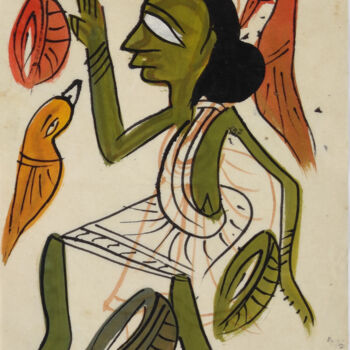santhal Pattachitra -43 (2001) 绘画 由 Minmoy Das
水彩在纸上, 7.5x5.5 in
US$146.33
价格:
免费送货
由
OPS Art Gallery
出售
发货地: 印度
(管)
在2天
在14天内可退换
全球发货
100%安全交易
免费退货
由Artmajeur交付:
从提货到最终交付给客户,Artmajeur会直接处理此艺术品的运输。
不包括海关.
更多信息
更多信息
- 包装 (管) 所有的作品都配有优质的承运方,经过严格的包装保护和已投保。
- 监控 跟踪订单,直到包裹交付给买方. 将提供跟踪号码,以便您可以实时跟踪包裹。
- 延迟 全球配送会在3-7天内送达 (估计)
- 不包括海关 价格不包括海关费用。大多数国家/地区对原创艺术品没有进口税,但您可能需要支付减免的增值税。海关费用(如果有)将由海关在抵达时计算,并由承运人单独计费。
Artmajeur 尽一切努力保证您以最公平的价格获得正宗的原创作品,或全额赔偿您。
更多信息
更多信息
- 可追踪的在线真品证书 可以通过扫描插图的代码随时在线验证真品证书。
- 认证评级艺术家 专家研究一个艺术家的工作和职业生涯,然后建立一个独立的,可靠的平均价格值。平均价格价值座落在一个价格范围内的某一时期的艺术家。专家们也可能被要求建立一个更精确的估计为特定的工作。
100%安全交易, 可接受的付款方式: 信用卡, PayPal, 银行转帐.
更多信息
更多信息
有保障的直接购买
交易由Artmajeur保证:只有在客户收到艺术品后,卖方才会获得付款。
使用SSL证书进行100%安全付款 + 3D Secure.
使用SSL证书进行100%安全付款 + 3D Secure.
免费退货: 在14天内可退换.
更多信息
更多信息
接受退货 14 天
Artmajeur 100%致力于使收藏家满意:您有14天的时间才能退还原始作品。作品必须以其原始包装完好无损地退还给艺术家。所有合格的物品均可退还(除非另有说明)。
其中的一种
艺术家签名的艺术品
包含真实性证书
-
原创艺术品 (One Of A Kind)
绘画,
水彩
在纸上
- 外形尺寸 高度 7.5in, 宽度 5.5in
- 分类 画作 低于US$500 部落艺术 日常生活
Revivalism in visual arts coupled with scholarly assessment of India’s ancient artistic heritage was a phase of India’s renaissance during the freedom movement. Over a period of fifteen hundred years, a continuous, consistent and ever growing tradition had existed in arts. Glimpses of this continuity in painting are traceable in the present day folk[...]
Revivalism in visual arts coupled with scholarly assessment of India’s ancient artistic heritage was a phase of India’s renaissance during the freedom movement. Over a period of fifteen hundred years, a continuous, consistent and ever growing tradition had existed in arts. Glimpses of this continuity in painting are traceable in the present day folk art, despite problems thrown up by the confrontation of a traditional society with a technological age.
Jamini Roy of the Bengal school, who, like many of his peers, understood the formal qualities, was the first among his peers to recognize the vitality of the myths and nature mysticism inherent in so called primitive and folk art. And he forged ahead visualizing valid alternatives in this art to mainstream western are introduced in the colonial period. A post modern and a contemporary artist in this age, he brought the Vaishnavite, Baul and Santal traditions visibility and precision in the world of art.
The Santhals are a tribe spread over the region of present day Bihar, Jharkhand and West Bengal states of the Indian subcontinent. Like any other tribe the Santals have an exclusive artistic perception rooted in their cultural traditions and physical environs.
The Santhals paint the walls of their huts during their village festival for ceremonial celebratory performances as also for self expression. They worship a stone, as a formless representation of the Divine, sing of the burthen of their life and provide a vivid portrayal of their day to day experiences, shared by animals and birds.
Done in primary colors, infested with leafy patterns in the foreground, background and borders, the Santhal paintings are characterized by a directness and a child like simplicity in the depiction of birds, animals and insects. The figures are static, frequently multicolor, artistic rather than realistic projections. Bodies of fish and birds are joined in one head. Mother and child as well as human, animal and bird couples are brought together by a philosophy of love and unions. A panoramic view of the village forms the backdrop, with women carrying firewood and water, men driving the bullock cart to the market, dancing and singing under a tree, a couple under flowering creepers; a family going for cultivation; men and women cutting wood, gathering fire wood, carrying water on the head; hunters returning with their catch ; fishing; taking mud pots in a cart to the village market for sale, flying kites and swinging, brothers of the bridegroom carrying the bride in a basket. These tell of the strong family bond and brimming with life diffusing a rare energy that animates Santhal art.
The colour scheme holds no logic. A bird or a fish appear in many colours. The picture is first drawn in black and then coloured. Originally, the Santhals used natural colours made from plants and stones, with a special and striking tinge. The older generation still sticks to natural colours while the young opt for synthetic colours. There also black and white paintings on canvas presented for archives or for sale today.
Santiniketan, a centre of excellence for Indian art, is associated with the iconic figure of Rabindranath Tagore, worldwide. The art of the Santhals gained prominence during his days Tagore got interested in the Santhals living in a hamlet close to Santiniketan and began to promote their art when he came across Nandalal Basu and appointed him as art teacher in Kala Bhavan. From this context arose an interest in folk arts and traditional crafts in Santiniketan and Sreeniketan. Soon an artist’s colony was established in 1930 near Santiniketan with Ramkinkar Baij, the Santhal painter and sculptor as one of its founding members. Today, those who visit Santiniketan come back with Ramkinkar indelibly etched in their memories.
Forms of arts change from age to age according to changing outlook, circumstances, methods and techniques. But folk art is brought into form in fidelity to natural and biological laws, operating within ethnological and geographical parameters. Today Santhal artists paint on canvases using acrylic for exhibitions and for sale although the older generation still sticks to their special colours obtained from plants, mud and other raw materials. The simplicity, virility and vitality of Santhal paintings, emerging from natural environs provide a fine chapter in the history of Indian arts, and needs to be sedulously nurtured.
Jamini Roy of the Bengal school, who, like many of his peers, understood the formal qualities, was the first among his peers to recognize the vitality of the myths and nature mysticism inherent in so called primitive and folk art. And he forged ahead visualizing valid alternatives in this art to mainstream western are introduced in the colonial period. A post modern and a contemporary artist in this age, he brought the Vaishnavite, Baul and Santal traditions visibility and precision in the world of art.
The Santhals are a tribe spread over the region of present day Bihar, Jharkhand and West Bengal states of the Indian subcontinent. Like any other tribe the Santals have an exclusive artistic perception rooted in their cultural traditions and physical environs.
The Santhals paint the walls of their huts during their village festival for ceremonial celebratory performances as also for self expression. They worship a stone, as a formless representation of the Divine, sing of the burthen of their life and provide a vivid portrayal of their day to day experiences, shared by animals and birds.
Done in primary colors, infested with leafy patterns in the foreground, background and borders, the Santhal paintings are characterized by a directness and a child like simplicity in the depiction of birds, animals and insects. The figures are static, frequently multicolor, artistic rather than realistic projections. Bodies of fish and birds are joined in one head. Mother and child as well as human, animal and bird couples are brought together by a philosophy of love and unions. A panoramic view of the village forms the backdrop, with women carrying firewood and water, men driving the bullock cart to the market, dancing and singing under a tree, a couple under flowering creepers; a family going for cultivation; men and women cutting wood, gathering fire wood, carrying water on the head; hunters returning with their catch ; fishing; taking mud pots in a cart to the village market for sale, flying kites and swinging, brothers of the bridegroom carrying the bride in a basket. These tell of the strong family bond and brimming with life diffusing a rare energy that animates Santhal art.
The colour scheme holds no logic. A bird or a fish appear in many colours. The picture is first drawn in black and then coloured. Originally, the Santhals used natural colours made from plants and stones, with a special and striking tinge. The older generation still sticks to natural colours while the young opt for synthetic colours. There also black and white paintings on canvas presented for archives or for sale today.
Santiniketan, a centre of excellence for Indian art, is associated with the iconic figure of Rabindranath Tagore, worldwide. The art of the Santhals gained prominence during his days Tagore got interested in the Santhals living in a hamlet close to Santiniketan and began to promote their art when he came across Nandalal Basu and appointed him as art teacher in Kala Bhavan. From this context arose an interest in folk arts and traditional crafts in Santiniketan and Sreeniketan. Soon an artist’s colony was established in 1930 near Santiniketan with Ramkinkar Baij, the Santhal painter and sculptor as one of its founding members. Today, those who visit Santiniketan come back with Ramkinkar indelibly etched in their memories.
Forms of arts change from age to age according to changing outlook, circumstances, methods and techniques. But folk art is brought into form in fidelity to natural and biological laws, operating within ethnological and geographical parameters. Today Santhal artists paint on canvases using acrylic for exhibitions and for sale although the older generation still sticks to their special colours obtained from plants, mud and other raw materials. The simplicity, virility and vitality of Santhal paintings, emerging from natural environs provide a fine chapter in the history of Indian arts, and needs to be sedulously nurtured.
相关主题
Tribal ArtFolk ArtIndian Tribal ArtIndian Folk ArtIndian Folk And Tribal Art







